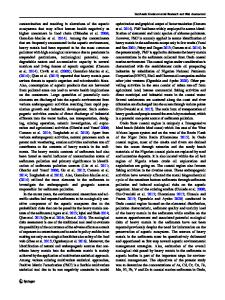Contamination assessment, health risk evaluation, and source identification of heavy metals in the soil-rice system of t
- PDF / 1,445,915 Bytes
- 11 Pages / 595.276 x 790.866 pts Page_size
- 36 Downloads / 361 Views
RESEARCH ARTICLE
Contamination assessment, health risk evaluation, and source identification of heavy metals in the soil-rice system of typical agricultural regions on the southeast coast of China Yanjun Ren 1 & Meng Lin 2,3 & Qingming Liu 1 & Zhonghao Zhang 4 & Xufeng Fei 5,6 & Rui Xiao 2 & Xiaonan Lv 5,6 Received: 30 January 2020 / Accepted: 11 October 2020 # Springer-Verlag GmbH Germany, part of Springer Nature 2020
Abstract To quantitatively assess heavy metal accumulation and potential ecological and human health risks as well as analyze the sources of metals in a typical soil-rice system located on the southeast coast of China, 120 topsoil samples and corresponding rice grain samples were collected across the study area. The concentrations of As, Cd, Pb, Cr, Hg, Zn, Cu, and Ni were analyzed. The results revealed that Hg, Cd, and Cu were the main pollutants in soils. Besides, according to geo-accumulation value of Hg, 18.3% of samples were at or above moderate contamination levels. Additionally, the soil was in moderate ecological risk from combined heavy metal pollution, and 49.7% and 27.0% of this risk could be attributed to Hg and Cd pollution, respectively, due to their high toxicresponse factors. For the rice samples, Cd content showed the highest biological accumulation coefficient value (40.8%) in rice grains and was slightly greater than its maximum allowable value (MAV) (0.2 mg/kg) in 7.5% of samples, whereas the other metals were all lower than their corresponding MAVs. Heavy metal exposure (especially As exposure) via rice consumption causes significant carcinogenic and non-carcinogenic risks to adults, and noncarcinogenic risk to children, while the carcinogenic risk to children was at tolerable level. Greater rice consumption might be responsible for the greater health risk to adults than children. Natural sources (loaded heavily with Cr and Ni) such as lithogenic components and soil parent materials, agricultural activities (loaded heavily with Cd, Cu, and Zn), especially excessive use of pesticides and fertilizers, and industrial activities (loaded heavily with Hg, Pb, and As) including vehicle emissions, coal combustion, and those of the textile and chemical industries were identified as the main sources. Effective regulations should be enforced to guarantee the safety of farm produce and protect ecological and human health in the study area. Keywords Heavy metal . Rice grain . Pollution assessment . Ecological risk . Health risk . Source identification
Responsible Editor: Gangrong Shi Supplementary Information The online version contains supplementary material available at https://doi.org/10.1007/s11356-02011229-6. * Xufeng Fei [email protected] 1
Hangzhou Center for Disease Control and Prevention, Hangzhou, China
2
School of Remote Sensing and Information Engineering, Wuhan University, Wuhan, China
3
Qingdao Urban Planning and Design Research Institute, Qiangdao, China
4
Institute of Urban Studies, School of Environmental and Geographical Sciences, Shanghai Normal University, Sh
Data Loading...











